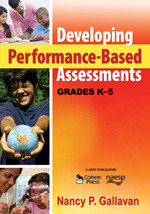Acknowledgments
About the Author
Introduction
1. Examining the Many Purposes of Assessment
Demystify Performance-Based Assessments
Understand the Six Components of Assessment
Picture the Continuous Flow of Assessment
Know the Reasons for Selecting Your Assessments...
Extend With Questions and Activities
2. Planning Assessments to Promote Understanding
Use Formal and Informal Assessments
Become a Data-Driven Teacher
Understand Assessment Principles and Practices
Watch for Common Errors in Assessing
Visualize the Overall Process...
Extend With Questions and Activities
3. Collecting Baseline Data for Preassessments
Set Three Goals to Guide Your Preassessments
Question Each of the Six Components of Assessment
Follow These Guidelines as You Preassess
Realize That Assessment Is a Continuous Process...
Extend With Questions and Activities
4. Aligning Appropriate Formative Assessments
Consider the Six Components of Assessment
Align Assessments With Curriculum and Instruction
Explore Cognition Via Patterns of Thought
Plan With Competence and Confidence...
Extend With Questions and Activities
5. Incorporating Learning, Assigning Instruction Followed by Feedback and Correction
Assign Your Instruction and Activities
Employ Multiple Instructional Strategies
Consider These Assessment Recommendations
Include All Kinds of Questions With Your Formative Assessments
Involve Your Learners in the Process
Have Fun With Formative Assessments...
Extend With Questions and Activities
6. Administering Summative Assessments
Connect to the Goals and Components of Assessment
Create Your Summative Assessments
Prepare Learners for Summative Assessments
Set Your Sights on the Five As
Continue the Assessment Cycle...
Extend With Questions and Activities
7. Identifying What to Assess: Inviting the Five Types of Inquiry and Information
Introduce the Five Types of Inquiry
Balance Three Conditions With Five Types of Inquiry
Enhance Variety in Your Inquiries
Include All Types of Thinking, Acting, and Feeling...
Extend With Questions and Activities
8. Analyzing How to Assess: Applying the Five Forms of Appraisal and Authentication
Analyze the Five Forms of Appraisal and Authentication
Implement Assessments Purposefully
Develop Appraisals to Showcase Learning...
Extend With Questions and Activities
9. Creating Assessment Templates and Rubrics
Construct the Assessment Template
Let Your Templates and Rubrics Do the Work for You...
Extend With Questions and Activities
10. Conducting Evaluations and Accountability
Concentrate on Your Effectiveness
Develop a Performance-Based Assessment Mindset...
Extend With Questions and Activities
References and Readings
Index
